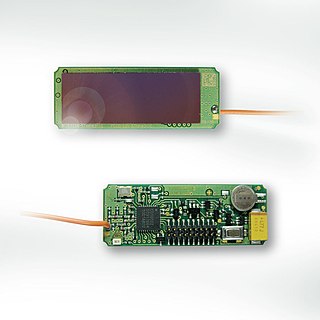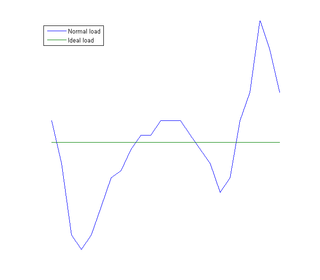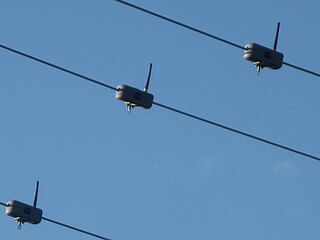
Automatic meter reading (AMR) is the technology of automatically collecting consumption, diagnostic, and status data from water meter or energy metering devices and transferring that data to a central database for billing, troubleshooting, and analyzing. This technology mainly saves utility providers the expense of periodic trips to each physical location to read a meter. Another advantage is that billing can be based on near real-time consumption rather than on estimates based on past or predicted consumption. This timely information coupled with analysis can help both utility providers and customers better control the use and production of electric energy, gas usage, or water consumption.

An electricity meter, electric meter, electrical meter, energy meter, or kilowatt-hour meter is a device that measures the amount of electric energy consumed by a residence, a business, or an electrically powered device.

The EnOcean technology is an energy harvesting wireless technology used primarily in building automation systems, but also in other application fields such as industry, transportation, logistics or smart homes solutions. The energy harvesting wireless modules are manufactured and marketed by the company EnOcean, headquartered in Oberhaching near Munich. The modules combine micro energy converters with ultra low power electronics and wireless communications and enable batteryless, wireless sensors, switches, and controls.
Building automation (BAS), also known as building management system (BMS) or building energy management system (BEMS), is the automatic centralized control of a building's HVAC, electrical, lighting, shading, access control, security systems, and other interrelated systems. Some objectives of building automation are improved occupant comfort, efficient operation of building systems, reduction in energy consumption, reduced operating and maintaining costs and increased security.

Interuniversity Microelectronics Centre (imec) is an international research & development organization, active in the fields of nanoelectronics and digital technologies with headquarters in Belgium. Luc Van den hove has served as president and CEO since 2009.

A smart meter is an electronic device that records information—such as consumption of electric energy, voltage levels, current, and power factor—and communicates the information to the consumer and electricity suppliers. Such an advanced metering infrastructure (AMI) differs from automatic meter reading (AMR) in that it enables two-way communication between the meter and the supplier.

Peak demand on an electrical grid is the highest electrical power demand that has occurred over a specified time period. Peak demand is typically characterized as annual, daily or seasonal and has the unit of power. Peak demand, peak load or on-peak are terms used in energy demand management describing a period in which electrical power is expected to be provided for a sustained period at a significantly higher than average supply level. Peak demand fluctuations may occur on daily, monthly, seasonal and yearly cycles. For an electric utility company, the actual point of peak demand is a single half-hour or hourly period which represents the highest point of customer consumption of electricity. At this time there is a combination of office, domestic demand and at some times of the year, the fall of darkness.

A smart city is a technologically modern urban area that uses different types of electronic methods and sensors to collect specific data. Information gained from that data is used to manage assets, resources and services efficiently; in return, that data is used to improve operations across the city. This includes data collected from citizens, devices, buildings and assets that is processed and analyzed to monitor and manage traffic and transportation systems, power plants, utilities, urban forestry, water supply networks, waste, criminal investigations, information systems, schools, libraries, hospitals, and other community services. Smart cities are defined as smart both in the ways in which their governments harness technology as well as in how they monitor, analyze, plan, and govern the city. In smart cities, the sharing of data is not limited to the city itself but also includes businesses, citizens and other third parties that can benefit from various uses of that data. Sharing data from different systems and sectors creates opportunities for increased understanding and economic benefits.

Load management, also known as demand-side management (DSM), is the process of balancing the supply of electricity on the network with the electrical load by adjusting or controlling the load rather than the power station output. This can be achieved by direct intervention of the utility in real time, by the use of frequency sensitive relays triggering the circuit breakers, by time clocks, or by using special tariffs to influence consumer behavior. Load management allows utilities to reduce demand for electricity during peak usage times, which can, in turn, reduce costs by eliminating the need for peaking power plants. In addition, some peaking power plants can take more than an hour to bring on-line which makes load management even more critical should a plant go off-line unexpectedly for example. Load management can also help reduce harmful emissions, since peaking plants or backup generators are often dirtier and less efficient than base load power plants. New load-management technologies are constantly under development — both by private industry and public entities.

The smart grid is an enhancement of the 20th century electrical grid, using two-way communications and distributed so-called intelligent devices. Two-way flows of electricity and information could improve the delivery network. Research is mainly focused on three systems of a smart grid – the infrastructure system, the management system, and the protection system. Electronic power conditioning and control of the production and distribution of electricity are important aspects of the smart grid.
GridPoint is an American clean technology company based in Reston, Virginia, that provides energy management and sustainability services to enterprises and government agencies, such as electric utilities.

Electricity pricing can vary widely by country or by locality within a country. Electricity prices are dependent on many factors, such as the price of power generation, government taxes or subsidies, CO
2 taxes, local weather patterns, transmission and distribution infrastructure, and multi-tiered industry regulation. The pricing or tariffs can also differ depending on the customer-base, typically by residential, commercial, and industrial connections.
Nonintrusive load monitoring (NILM), nonintrusive appliance load monitoring (NIALM), or energy disaggregation is a process for analyzing changes in the voltage and current going into a house and deducing what appliances are used in the house as well as their individual energy consumption. Electric meters with NILM technology are used by utility companies to survey the specific uses of electric power in different homes. NILM is considered a low-cost alternative to attaching individual monitors on each appliance. It does, however, present privacy concerns.

A home energy monitor is a device that provides information about a personal electrical energy usage to a consumer of electricity. Devices may display the amount of electricity used, plus the cost of energy used and estimates of greenhouse gas emissions. The purpose of such devices is to assist in the management of power consumption. Several initiatives has been launched to increase the usage of home energy monitors. Studies have shown a reduction of home energy when the devices are used.
Energy Management Software (EMS) is a general term and category referring to a variety of energy-related software applications which may provide utility bill tracking, real-time metering, building HVAC and lighting control systems, building simulation and modeling, carbon and sustainability reporting, IT equipment management, demand response, and/or energy audits. Managing energy can require a system of systems approach.

Electricity theft is the criminal practice of stealing electrical power. The practice of stealing electricity is nearly as old as electricity distribution. Electricity theft is accomplished via a variety of means, from methods as rudimentary as directly hooking to a power line, to manipulation of computerized electrical meters. Electricity theft is most common in developing countries where power grids deliver inadequate and unreliable power. The global cost of electricity theft was estimated at $96 billion every year. Some punishments for the crime include fines and incarceration. The electricity losses caused by the theft are classified as non-technical losses.
The OpenHAN standards for home networks was promoted by groups such as openAMI and UtilityAMI. Both efforts aim to standardize powerline networking interoperation from a utility point of view and ensure reliable communications co-extant with AC power outlets. Both utilities and vendors of home control have promoted such standards aggressively. The openHAN label usually denotes standards favored by the utilities, not other service providers. It should be distinguished from the openADR standards that were promoted to ensure open access to customer electricity use data by all service providers.
The UCLA Smart Grid Energy Research Center (SMERC), located on the University of California Los Angeles (UCLA) campus, is an organization focused on developing the next generation of technologies and innovation for Smart Grid. SMERC partners with government agencies, technology providers, Department of Energy (DOE) research labs, universities, utilities, policymakers, electric vehicle manufacturers, and appliance manufacturers. These partnerships provide SMERC with diverse capabilities and exceptional, mature leadership.

ecobee is a Canadian founded home automation company that makes smart thermostats, temperature and occupancy sensors, smart light switches, smart cameras, and contact sensors. They were acquired by the American company Generac Holdings in 2021.

A Wireless powerline sensor hangs from an overhead power line and sends measurements to a data collection system. Because the sensor does not contact anything but a single live conductor, no high-voltage isolation is needed. The sensor, installed simply by clamping it around a conductor, powers itself from energy scavenged from electrical or magnetic fields surrounding the conductor being measured. Overhead power line monitoring helps distribution system operators provide reliable service at optimized cost.














